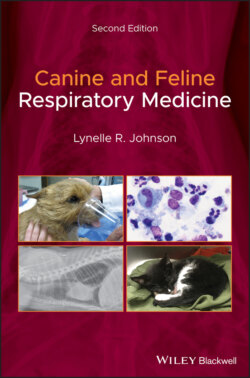Читать книгу Canine and Feline Respiratory Medicine - Lynelle Johnson R., Lynelle R. Johnson - Страница 15
Physical Examination
ОглавлениеA complete physical examination is essential in every animal presented for evaluation of respiratory disease. In animals with nasal discharge, important features to focus on include the presence or absence of nasal airflow, changes in ocular retropulsion, ability to depress the soft palate easily into the dorsal nasopharyngeal wall, regional local lymph node enlargement, and facial asymmetry or pain. These parts of the physical examination are most important because they can help identify the space‐occupying nature of some causes of nasal disease, particularly nasal neoplasia, feline cryptococcosis, feline aspergillosis, and nasopharyngeal polyps, and because these physical examination findings can indicate local extension or metastasis.
Nasal airflow can be assessed by holding a chilled microscope slide in front of each nostril to show fogging of the glass or by using a wisp of cotton (from a cotton ball or swab) to watch for air movement. The mouth should be held closed during the procedure, and occlusion of the alternate nostril can be helpful for enhancing airflow through the side of the nasal cavity to be examined (Figure 1.1). Cats create minimal airflow and a very thin wisp of cotton should be used and held in front of the nostril from above and below to check for flow. Alternatively, the stethoscope can be used to listen for airflow from each nostril. An animal with a mass effect in the nasal cavity or nasopharynx will fail to fog the glass, move the cotton wisp, or generate a sound at the stethoscope, and will often object to having the nose partly obstructed because it inhibits airflow. Conversely, even animals with heavy mucus accumulation in the nasal cavity will typically retain nasal airflow.
Figure 1.1 Nasal airflow can be assessed by occluding one nostril and assessing flow from the alternate nostril with a cotton wisp or chilled microscope slide.
Facial palpation is performed to assess for a pain response, to locate swellings and depressions in bony structures, and to check for symmetry of the skull. Neoplastic processes and fungal infections are most likely to result in abnormal findings. Ocular retropulsion is a part of the facial examination and is performed by placing each thumb over the closed lids and pressing gently backward, upward, medially, and laterally (Figure 1.2). Nasal lesions that are producing a mass effect behind the globe (primarily a neoplasm, fungal granuloma, or retrobulbar abscess) will cause a lateralizing difference in the resistance to depression. Altered retropulsion is difficult to assess in a brachycephalic animal. Palpation within the oral cavity can reveal bony abnormalities in the hard palate or might suggest a mass lesion above the soft palate. To perform this examination, the mouth is held open, and the roof of the mouth is palpated from the front of the hard palate through to the end of the soft palate. In the normal animal, the soft palate is readily depressed upward into the dorsal nasopharyngeal wall (Figure 1.3). A mass in this area (most commonly a neoplasm, fungal granuloma, or polyp) will resist depression. The dental arcade should also be evaluated during the oral examination, although it is important to remember that tooth root disease can be present in the absence of external signs.
Figure 1.2 Palpation during ocular retropulsion can suggest the presence of a mass lesion in the optic canal or retrobulbar space.
Figure 1.3 In the normal animal, palpation of the soft palate will readily depress tissue into the dorsal nasopharyngeal wall. The presence of a mass lesion in the nasopharynx will result in resistance to depression.
Neoplastic disease or cryptococcosis within the nasal cavity leads to ipsilateral mandibular lymph node involvement and the disease process can sometimes be identified by cytology of a lymph node aspirate, even when there is no palpable enlargement. Nasal aspergillosis can result in reactive lymphadenopathy, although no fungal elements will be found. Nasal depigmentation along the drainage path of nasal discharge is a relatively specific feature of canine nasal aspergillosis found in up to 40% of cases and is thought to result from elaboration of a dermonecrotic toxin by the fungus (see Chapter 4).
